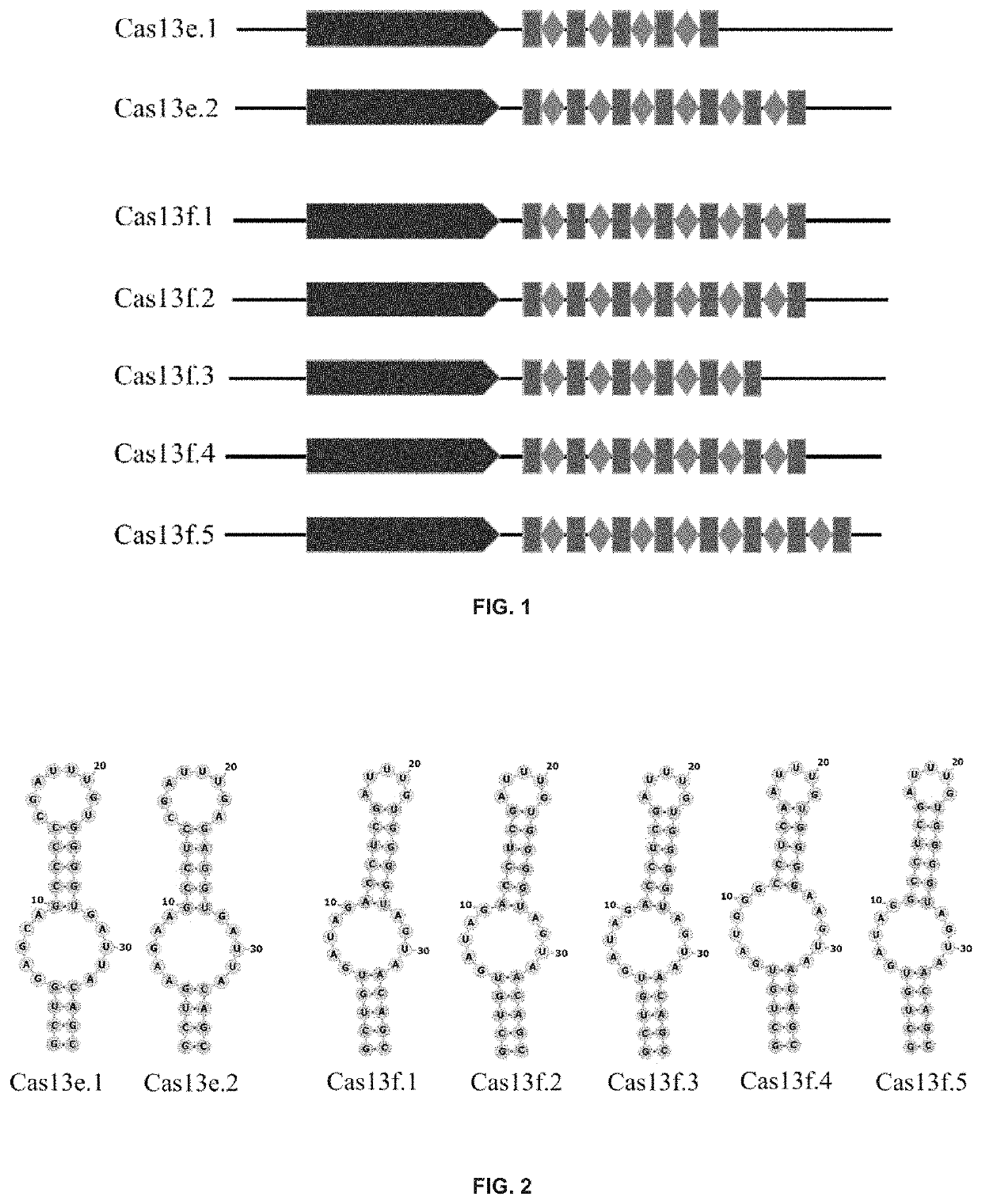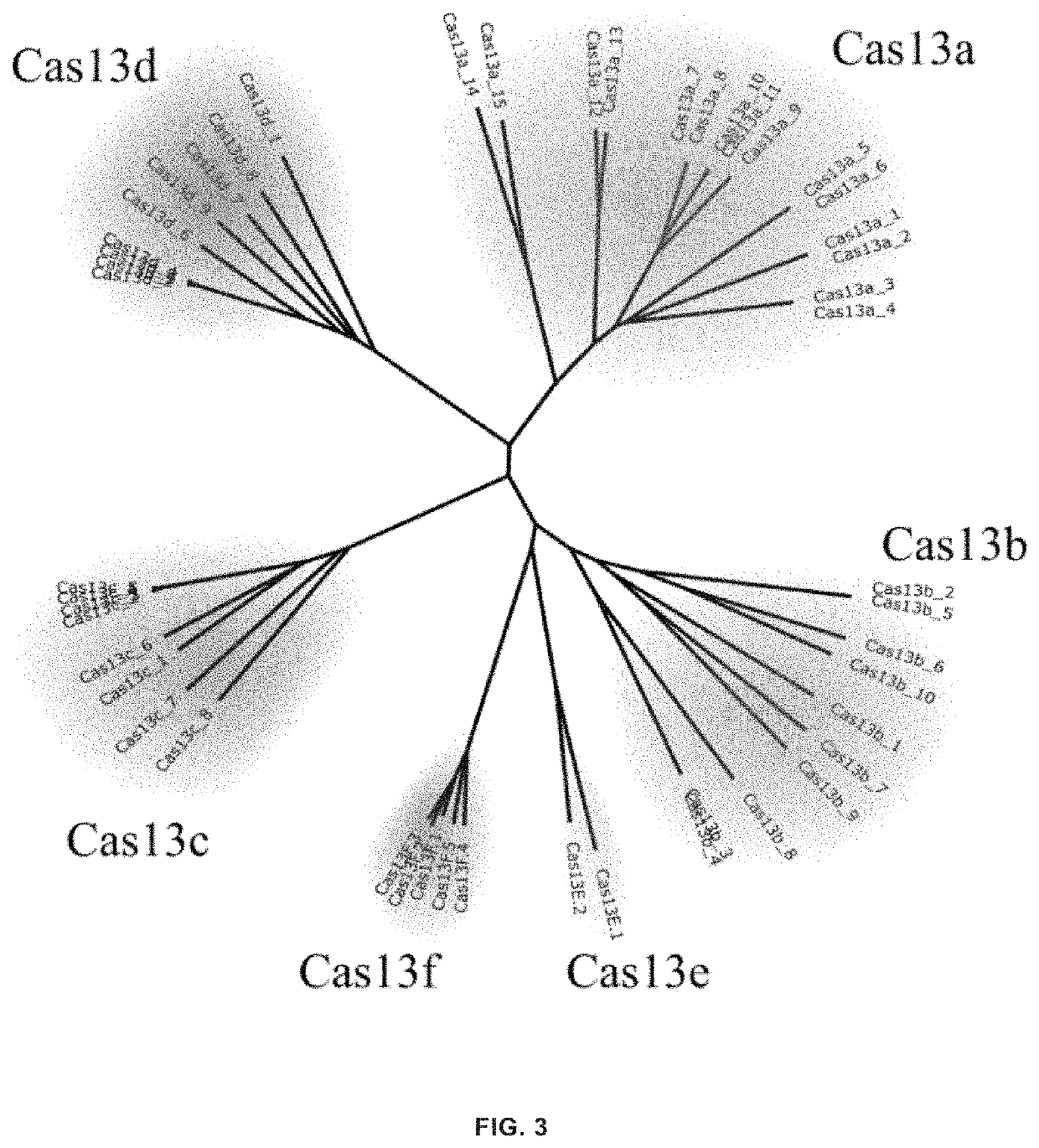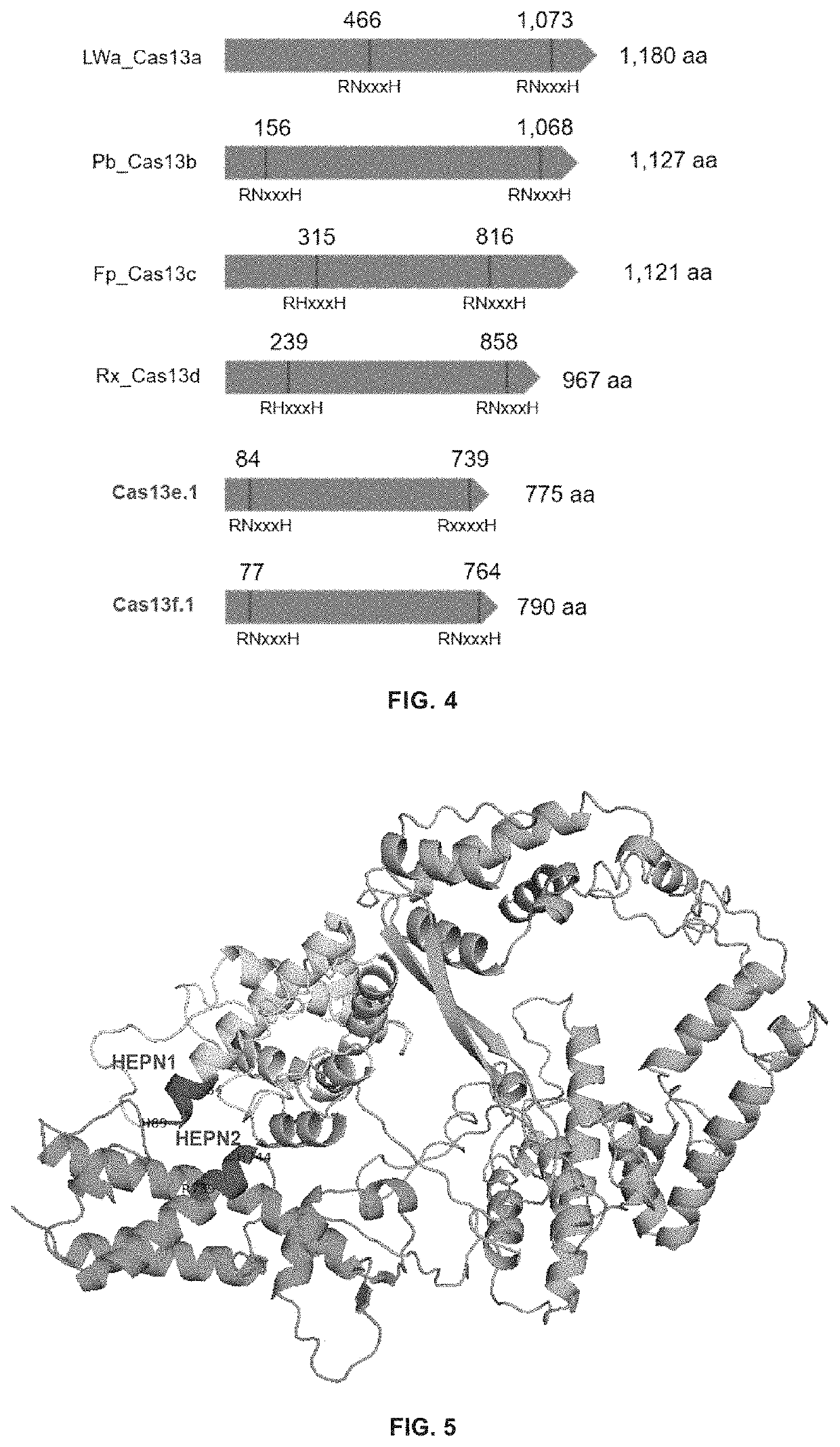Type VI-E and type VI-F CRISPR-Cas system and uses thereof
a technology which is applied in the field of type vif and type vif crisprcas systems, can solve the problems of large potential danger for gene therapy use, large size of the cas13 protein, and difficulty, if possible at all
- Summary
- Abstract
- Description
- Claims
- Application Information
AI Technical Summary
Benefits of technology
Problems solved by technology
Method used
Image
Examples
example 1
Identification of Novel Cas13e and Cas13f Systems
[0357]A computational pipeline was used to produce an expanded database of class 2 CRISPR-Cas systems from genomic and metagenomic sources. Genome and metagenome sequences were downloaded from NCBI (Benson et al., 2013; Pruitt et al., 2012), NCBI whole genome sequencing (WGS), and DOE JGI Integrated Microbial Genomes (Markowitz et al., 2012). Proteins were predicted (Prodigal (Hyatt el al., 2010) in anon mode) on all contigs at least 5 kb in length, and de-duplicated (i.e., removing identical protein sequences) to construct a complete protein database. Proteins larger than 600 residues were considered as Large Proteins (LPs). Since the currently identified Cas13 proteins are mostly larger than 900 residues in size, in order to reduce the complexity of calculation, only Large Proteins were considered further.
[0358]CRISPR arrays were identified using Piler-CR (Edgar, PILER-CR: Fast and accurate identification of CRISPR repeats. BMC Bioi...
example 2
Cas13e is an Effector RNase
[0377]In order to confirm that the newly identified Cas13e proteins are effective RNase functioning in the CRISPR / Cas system, Cas13e.1 coding sequence was codon optimized for human expression (SEQ ID NO: 22), and cloned into a first plasmid with GFP gene. Meanwhile, coding sequence for guide RNA (gRNA) targeting the reporter gene (mCherry) mRNA was cloned into a second plasmid with GFP gene. The gRNA consists of a spacer coding region flanked by two direct repeat sequences for Cas13e.1 (SEQ ID NO: 29). The sequence of GFP and mCherry reporter genes are SEQ ID NO: 30-31, respectively.
[0378]
(SEQ ID NO: 29)GCTGGAGCAGCCCCCGATTTGTGGGGTGATTACAGCGGTCTTCGATATTCAAGCGTCGGAAGACCTGCTGGAGCAGCCCCCGATTTGTGGGGTGATTACAGC(SEQ ID NO: 30)ATGGTGAGCAAGGGCGAGGAGGATAACATGGCCATCATCAAGGAGTTCATGCGCTTCAAGGTGCACATGGAGGGCTCCGTGAACGGCCACGAGTTCGAGATCGAGGGCGAGGGCGAGGGCCGCCCCTACGAGGGCACCCAGACCGCCAAGCTGAAGGTGACCAAGGGTGGCCCCCTGCCCTTCGCCTGGGACATCCTGTCCCCTCAGTTCATGTACGGCTCCAAGGCCTACGTGAAGCACCC...
example 3
Effective Direction of sgRNA for Cas13e
[0381]Since Cas13e system can in theory utilize either the DR+Spacer (5′DR) or the Spacer+DR (3′DR) orientation, this experiment was designed to determine which is the correct orientation utilized by Cas13e.
[0382]Using a similar triple transfection experiment setting as in Example 2, it was found that only the 3′DR orientation (Spacer+DR) supported significant mCherry knock down. This demonstrated that Cas13e utilizes its crRNA with the DR sequence at the 3′-end of the spacer. See FIG. 9.
[0383]SgRNA of DR+Spacer (5′ DR) and Spacer+DR (3′ DR) are SEQ ID NOs: 32 and 33, respectively.
[0384]
(SEQ ID NO: 32)GCTGGAGCAGCCCCCGATTTGTGGGGTGATTACAGCGGTCTTCGATATTCAAGCGTCGGAAGACCT(SEQ ID NO: 33)GGTCTTCGATATTCAAGCGTCGGAAGACCTGCTGGAGCAGCCCCCGATTTGTGGGGTGATTACAGC
PUM
| Property | Measurement | Unit |
|---|---|---|
| secondary structure | aaaaa | aaaaa |
| RNase catalytic activity | aaaaa | aaaaa |
| size | aaaaa | aaaaa |
Abstract
Description
Claims
Application Information
 Login to View More
Login to View More - R&D
- Intellectual Property
- Life Sciences
- Materials
- Tech Scout
- Unparalleled Data Quality
- Higher Quality Content
- 60% Fewer Hallucinations
Browse by: Latest US Patents, China's latest patents, Technical Efficacy Thesaurus, Application Domain, Technology Topic, Popular Technical Reports.
© 2025 PatSnap. All rights reserved.Legal|Privacy policy|Modern Slavery Act Transparency Statement|Sitemap|About US| Contact US: help@patsnap.com



